
NSW State Seasonal Update - November 2020
Prepared by NSW DPI
NSW overview
Drought recovery continued across most of New South Wales (NSW) during November 2020, despite a dryer and warmer than average month. The NSW DPI Combined Drought Indicator (CDI) shows 90% of NSW is in the Non-Drought or Recovery categories. Favourable spring conditions have supported recovery from the 2017-2020 drought in many regions. The official climate outlook indicates moderate to high probabilities of above median rainfall across NSW for the next three months.
Dry November conditions have aided the NSW winter crop harvest, despite storm damage in some isolated locations earlier in the month. Yield and grain quality loss has occurred in these areas, especially in the north and western areas of the winter cropping zone. There have also been reports of storm related damage occurring to emerging summer crops. Irrigated summer crop potential remains poor in the northern irrigation valleys due to low water availability, though there have been reports of increased steam flows in some areas.
Early spring rainfall supported high levels of spring pasture productivity. This has increased the confidence of longer-term drought recovery in most regions.
Although the Pacific Ocean is in a La Niña pattern, NSW remained drier than average in November. Local climatic factors such as warm sea surface temperatures on the east coastline were dominant, resulting in reduced cloud cover, higher air pressure and less rainfall. High month-to-month rainfall variability is common in Australia, and it is not unusual for rainfall to be below average for one month in an above average season (3 months).
The expectation is that La Niña will begin to be more dominant than local factors in the coming months. The official three-month Seasonal Outlook from the Bureau of Meteorology (BoM) indicates moderate to high probabilities of above median rainfall across NSW. This is largely driven by the La Niña event that is forecast to persist into February 2021. La Niña is associated with above to well-above median rainfall during spring and summer, including the possibility of flood events.
The CDI and its individual rainfall, soil moisture and crop/pasture growth metrics are leading biophysical indices of drought. While the CDI currently points to a strengthening recovery and transition out of biophysical drought for large areas of NSW, production and economic responses lag behind the CDI. Full drought recovery can take 6-18 months depending on a number of influences including rainfall. Further information about the correct interpretation of the CDI at a region and industry level is provided in the regional breakdown section of this report.
Drought Support
Producers and members of rural communities are encouraged to maintain contact with their local professionals who can facilitate access to appropriate support. If you or someone you know needs support, please visit DroughtHub. Alternatively, you can contact the DPI Rural Resilience Team, Rural Financial Counsellors, or your Local Land Services representatives.
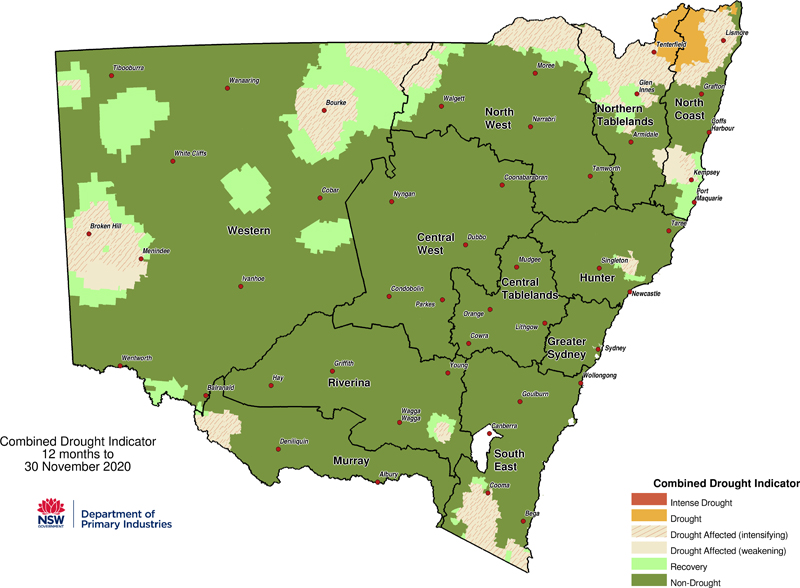
It is important to recognise the CDI provides an aggregated view of the State, and that on-ground conditions can be different to those displayed in the maps. They provide an ‘on average’ view of a particular region only. To report local conditions, use DPI Farm Tracker.
Rainfall
The rainfall anomaly data shows the difference between total monthly rainfall and the long-term average (1961-1990; Figure 2a). Lower than average November anomalies were recorded throughout NSW. Rainfall was higher than average in the parts of the South East, central and Western NSW.
Most of NSW has received less than 50mm of rainfall during November (Figure 2b) and less than 5mm in parts of western NSW. Higher totals (above 100mm) were received in parts of the South East Local Land Services region.
Rainfall accumulation for 2020 has been near or above average across NSW. Large areas across eastern NSW have accumulated totals of above 600mm (Figure 2c). Higher totals of more than 1,000mm have been received along parts of the eastern seaboard, with some above 1,400mm in the North Coast and South Coast LLS regions, Blue Mountains and alpine region. The far west has received 100mm or more for the year, though the rainfall has been variable.
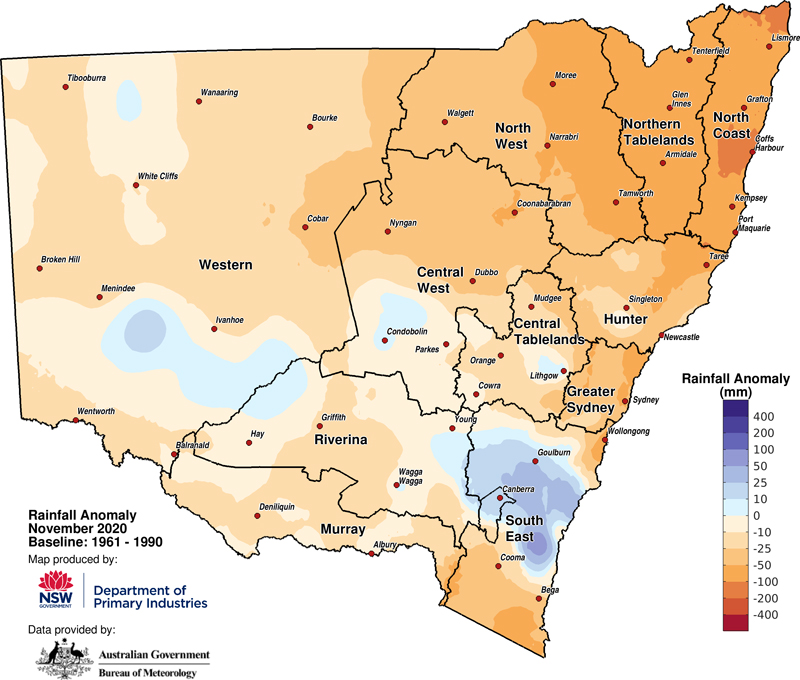
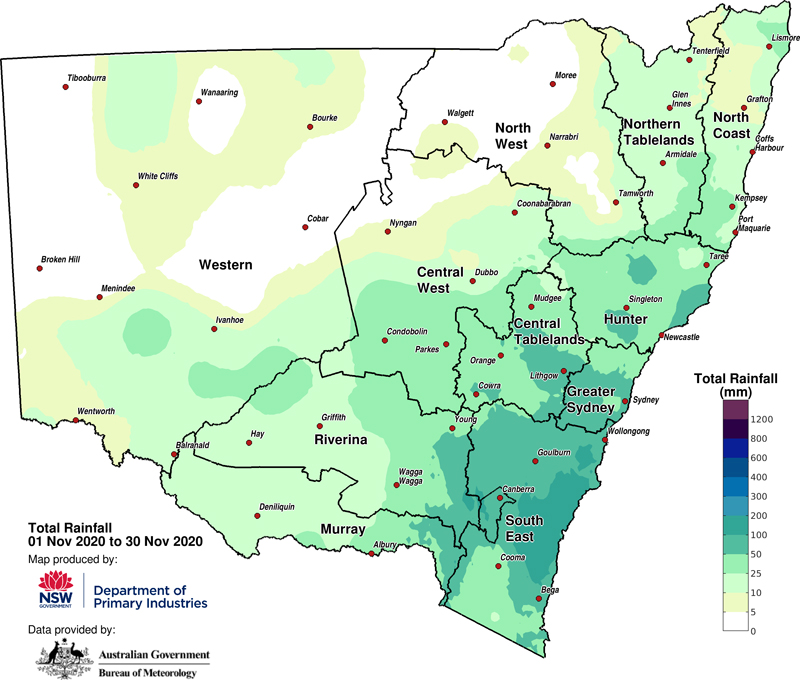
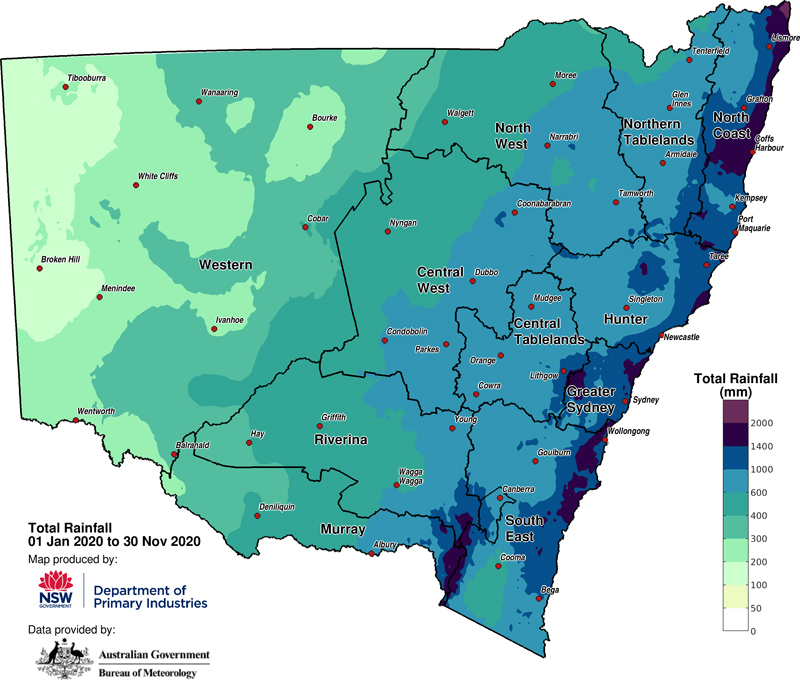
Temperature
Maximum temperatures in November were generally 1-5°C higher than average across most of NSW (Figure 3a), and up to 6°C warmer in some areas. The average maximum temperatures recorded in November (Figure 3b) were warmest across northern NSW (above 36°C). Elsewhere temperatures ranged between 24-36°C, while the tablelands and alpine regions experienced maximum average temperatures between 12-27°C.
Minimum temperature anomalies for November were generally 0-4°C warmer than average across most of NSW (Figure 3c). Most of NSW experienced average minimum temperatures above 9°C during the month and above 18°C in western regions (Figure 3d). Higher altitudes had minimum temperatures ranging between 3-12°C.
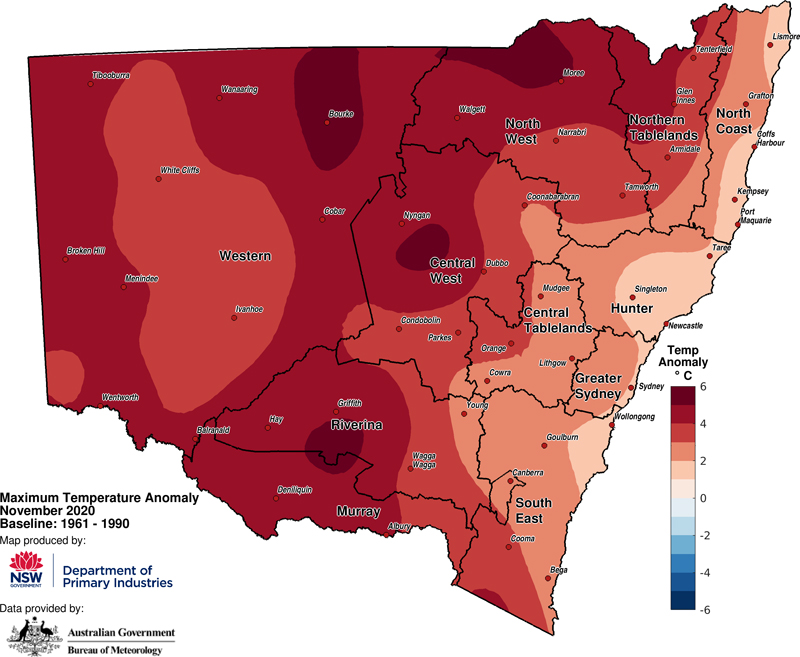
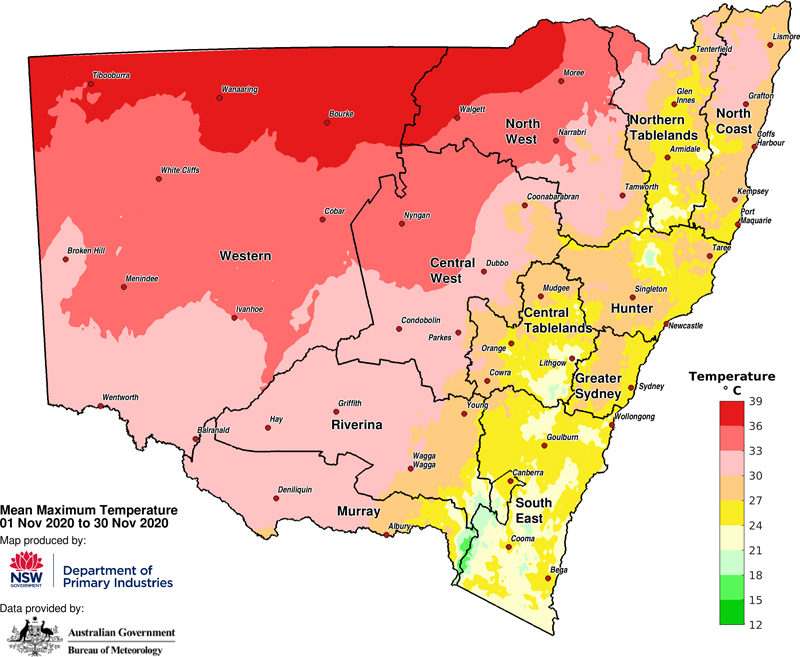
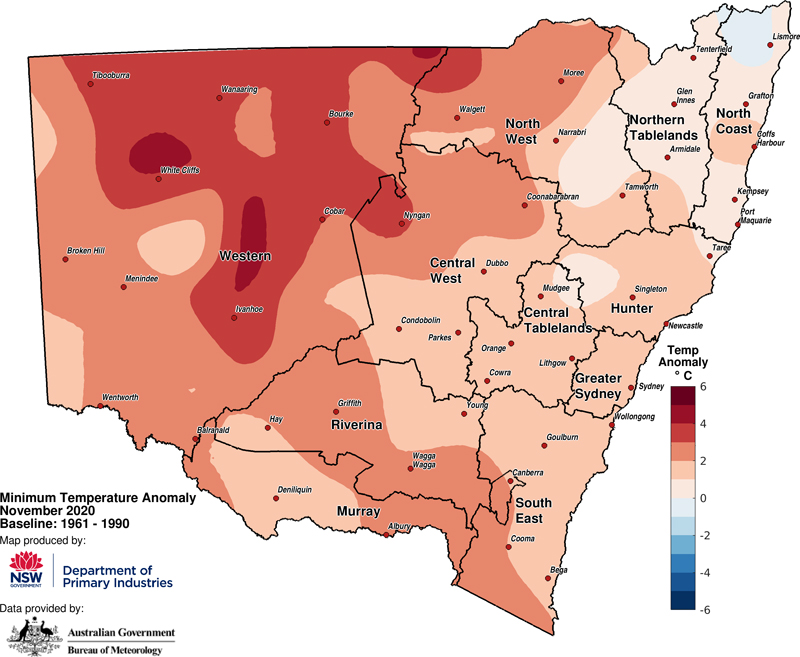
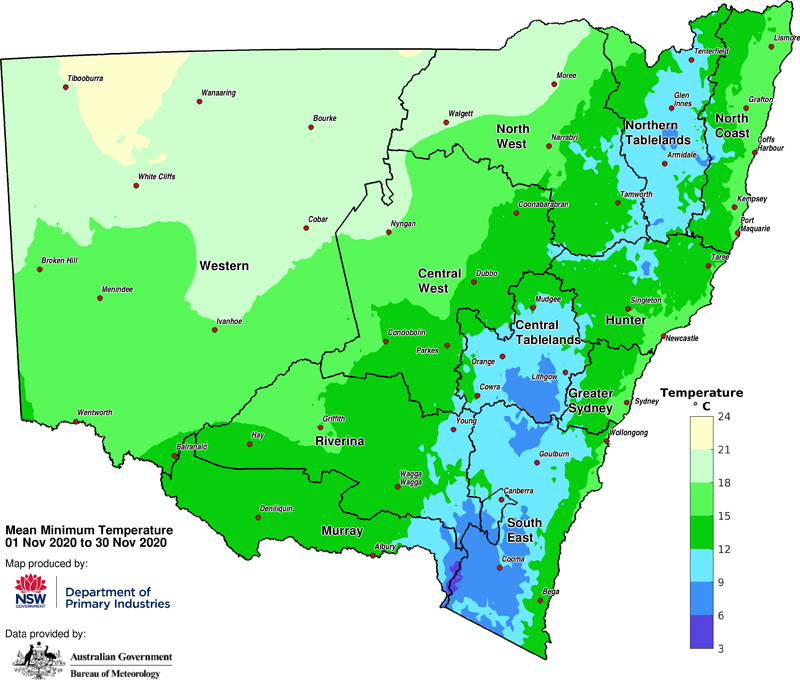
Normalised Difference Vegetation Index (NDVI) Anomaly
The seasonal Normalised Difference Vegetation Index (NDVI, Figure 4) indicates that plant greenness levels are close to, or above normal across large areas of NSW for the September to November period. Plant greenness levels remain variable in western and northern NSW while low plant greenness remains evident in much of the bushfire affected areas of the Central Tablelands, South East and Alpine areas of the state.
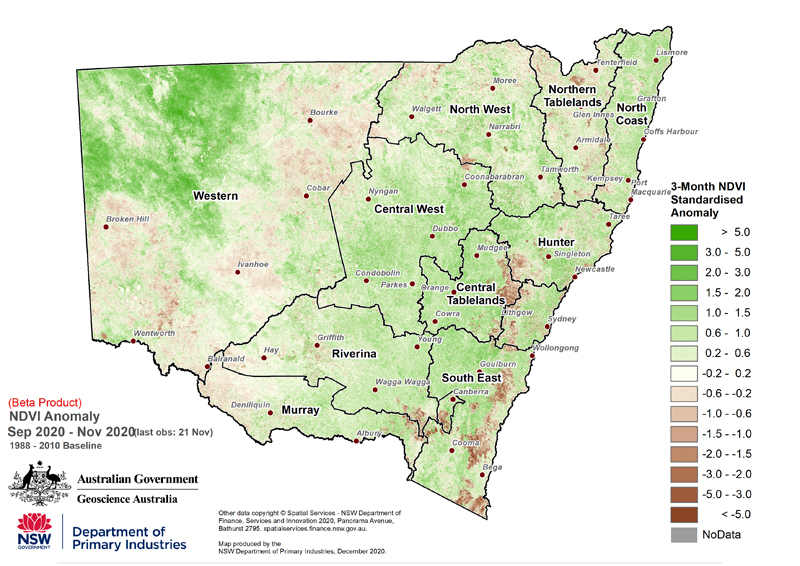
NSW Farm Dam Survey
The latest data from the NSW Farm Dam Survey (Figure 5) indicates that dam levels in most central regions of the state are above 40% of capacity. There has been a rapid improvement to dam levels in the far west due to rainfall over recent weeks. Deficiencies of less than 20% of dam capacity remain evident in parts of the Western, Murray, Riverina, North West, North Coast and Northern Tablelands Local Land Services (LLS) regions.
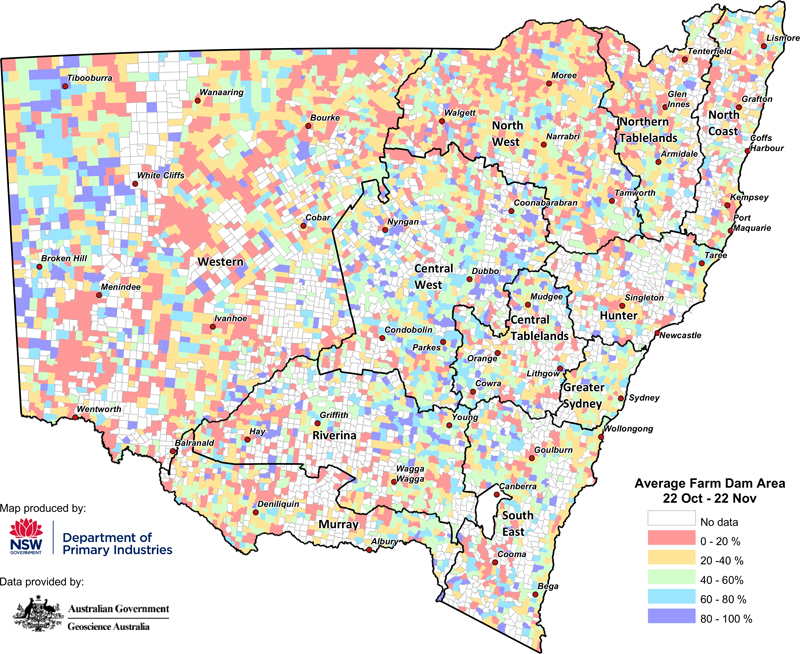
Significant Events
The Bureau of Meteorology reports that NSW recorded its direst November in 18 years and its 5th warmest November on record. A severe heatwave occurred at the end of the month.
Soil Water Index
The Soil Water Index (SWI, Figure 6) continues to improve and the majority of NSW is currently at average or above average levels. Parts of western, northern and southern NSW continue to be experiencing below average to extremely low soil water values.
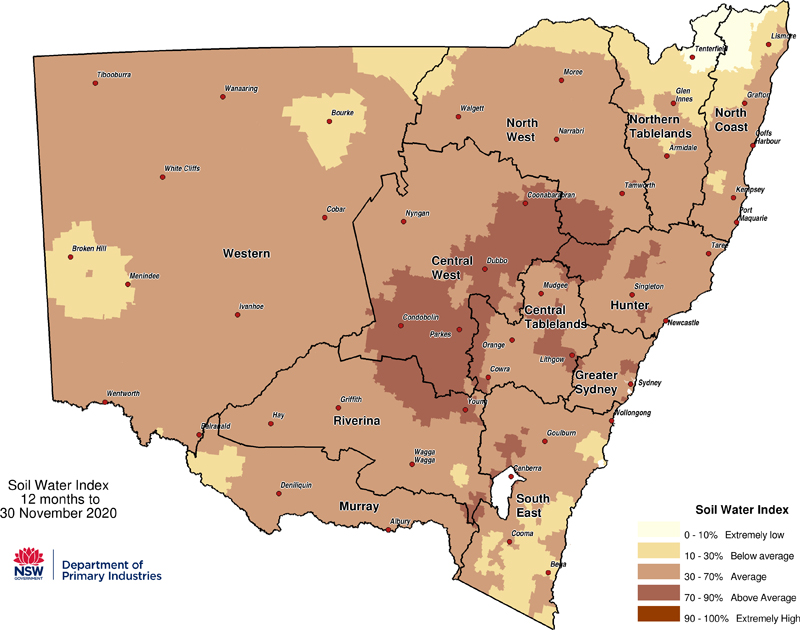
Plant Growth Index
The Plant Growth Index (PGI, Figure 7) response generally mirrors the SWI with large areas of the NSW in the average category at the end of November. However, parts of the far west, south east and north east continue to be experiencing below average to extremely low plant growth values.
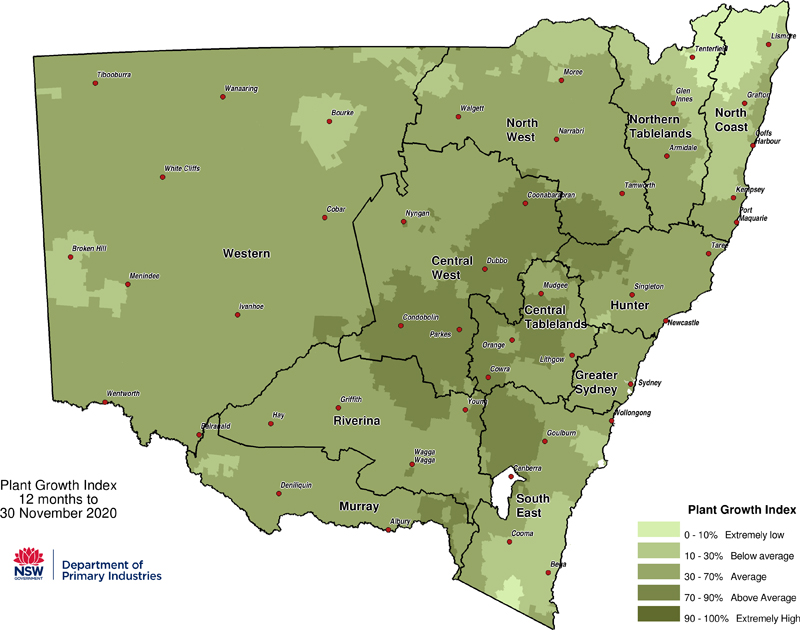
Rainfall Index
Rainfall accumulation during 2020 has improved the Rainfall Index (RI, Figure 8) across NSW. The majority of NSW is currently in the average or above average category. Parts of northern NSW are currently in the below average and extremely low category.
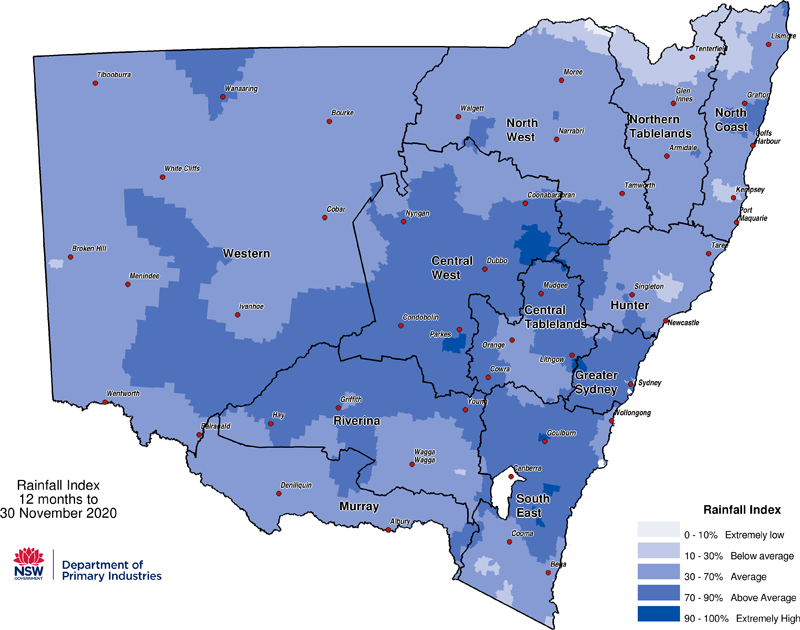
Drought Direction Index
The Drought Direction Index (DDI, Figure 9) tracks the 150-day trend of daily rainfall totals. The DDI shows that most of the state is displaying a neutral to strong drying trend. In contrast some areas in western, southern and northern NSW show a weak to strong wetting trend over the last 150 days.
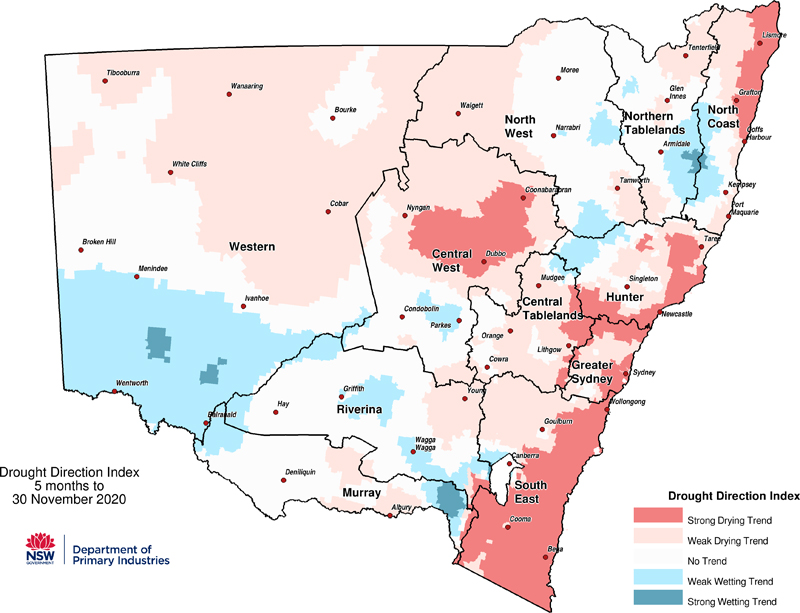
Changes in the individual drought indicators may have occurred since this update was released. For the most current information, please visit DroughtHub.
CDI status for the regions
Figure 10 displays the CDI status for each individual Local Land Services regions to 30 November 2020. The following regional descriptions are based on data available until the end of November 2020.
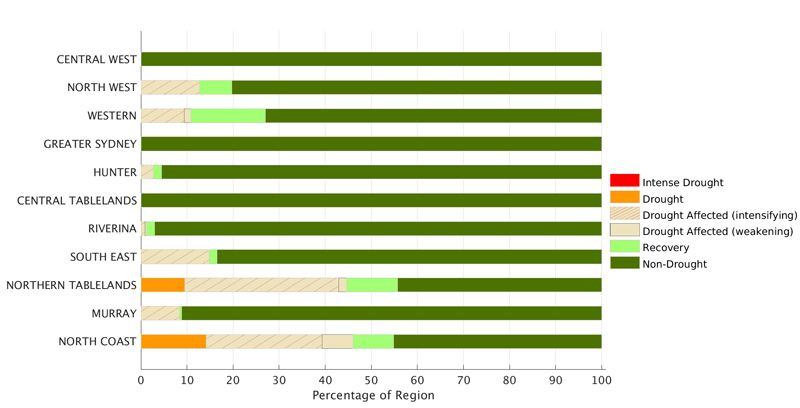
Murray and Riverina regions
The Combined Drought Indicator (CDI; Figure 11) shows that large areas of the Riverina and Murray Local Land Services (LLS) regions continue to transition through a recovery from drought conditions. Dry November conditions have aided the NSW winter crop harvest, and the rain that have been received has helped to maintained good spring conditions. Most of the region is currently in the Non-Drought CDI category. Some areas in the south west and around Tumut remain in the Drought Affected category. Further rain is needed to provide longer-term confidence for drought recovery in these areas.
The seasonal NDVI anomaly data (Figure 12) shows that the region is predominately experiencing near normal to higher than normal plant greenness levels for the September to November period. Greenness levels are still below average in the western part of the region. The impact of the recent bush fires is still evident south of Tumut.
The time series charts (Figure 13) show the individual response of the drought indices for Hay, Finley, Temora and Moulamein. The Hay, Finley and Temora charts show that conditions continue to improve and highlights the effectiveness of more consistent follow-up rainfall over recent months. The Moulamein chart shows that conditions plateaued during May to June. Rain in late October and November has recently improved the indices. Follow up rainfall is needed to aid the transition to drought recovery.
The Combined Drought Indicator (CDI) is a tool that monitors drought conditions across NSW. The drought categories are based on assessing the response of three drought indicators: soil water, plant growth and rainfall. The indicators track the data over the past 12 months and shows how the indices are tracking compared to the long-term averages. The information provided in the map is aggregated to a Parish level and provides a regional assessment of conditions. Variability within and between farms is possible and this may not be reflected in the CDI map.
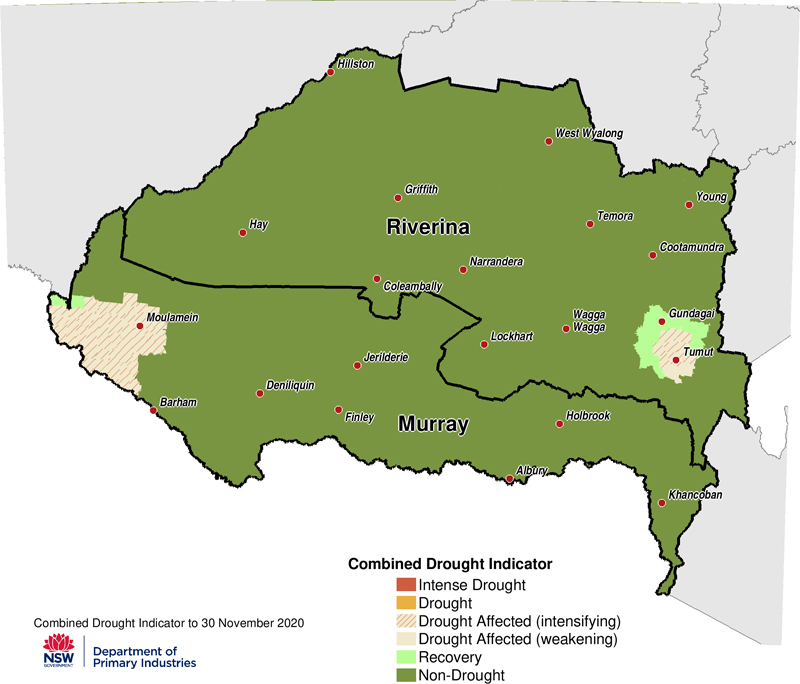
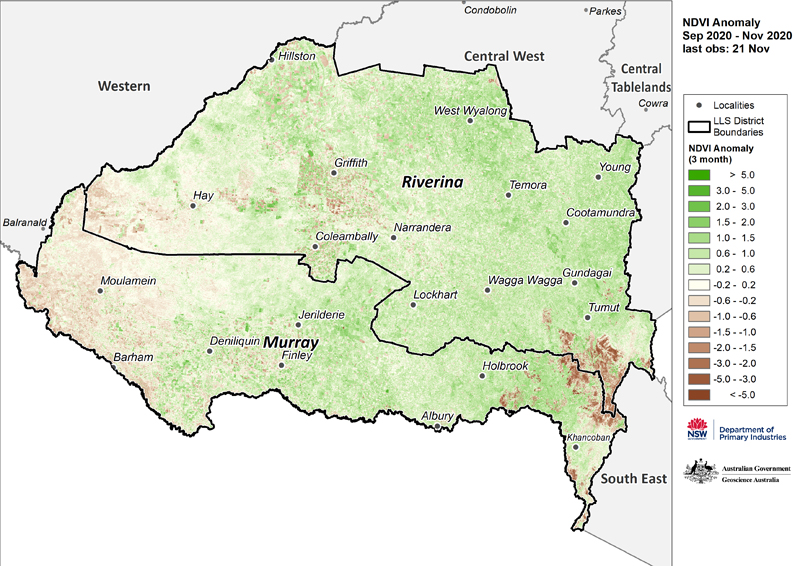
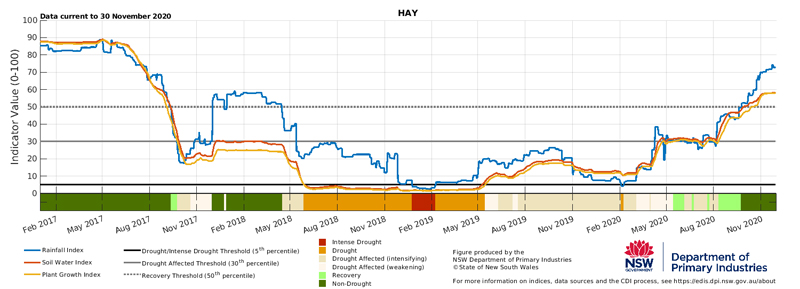
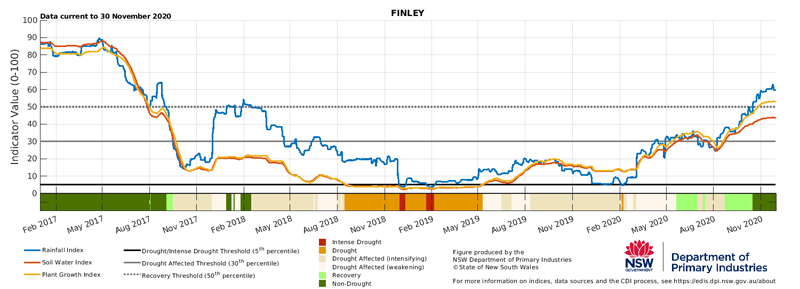
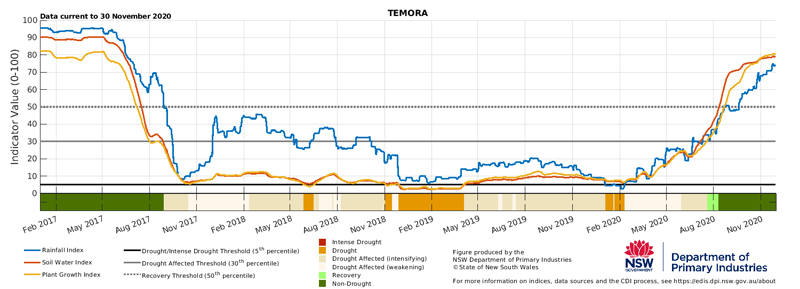
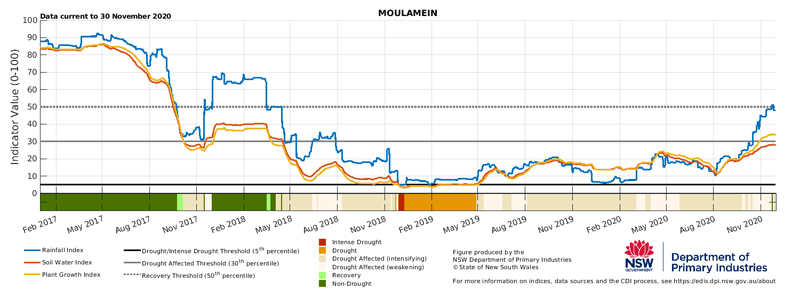
Western region
There has been little change in conditions in the Western Local Land Services region since the October Update. The Combined Drought Indicator (CDI) shows that most of the region continues to be in the Recovery or Non-Drought categories (Figure 14). On ground reports also highlight the variation in on-ground conditions across the region, a result of rainfall patterns and land management.
The NSW DPI advises that conditions remain variable in the Western LLS region. Recent rainfall has begun recovery, however further rainfall is needed, particularly in areas that have only received rainfall more recently. Drought management continues and further follow-up rain remains a key focus in these areas, particularly as hot summer temperatures come into effect.
The seasonal NDVI anomaly data (Figure 15) shows high variability in plant greenness levels across the region compared to long-term expectations for the September to November period. There has been a general improvement in plant greenness levels since the October Update. Some districts are experiencing well above normal levels of greenness while other districts continue to experience below normal levels of greenness (brown areas on the map). Rainfall has been lower, later or less effective in these areas.
The time series charts (Figure 16) show the individual response of the drought indices for Bourke, Ivanhoe and Wentworth. All three locations show variable rainfall patterns and responses in the soil water and plant growth indices. Conditions continue to improve in the Wentworth and Ivanhoe parishes, and highlights the effectiveness of more consistent follow-up rainfall over recent months. Bourke parish has experienced a transition back into the Drought Affected category. This highlights the importance on effective follow-up rainfall to maintain longer-term drought recovery. To access a time series for your Parish, visit the Combined Drought Indicator website.
The Combined Drought Indicator (CDI) is a tool that monitors drought conditions across NSW. The drought categories are based on assessing the response of three drought indicators: soil water, plant growth and rainfall. The indicators track the data over the past 12 months. This is then ranked against all other 12-month periods. This shows how the indices are tracking compared to the long-term averages. The information provided in the map is aggregated to a Parish level and provides a regional assessment of conditions. Variability within and between farms is possible and this may not be reflected in the CDI map.
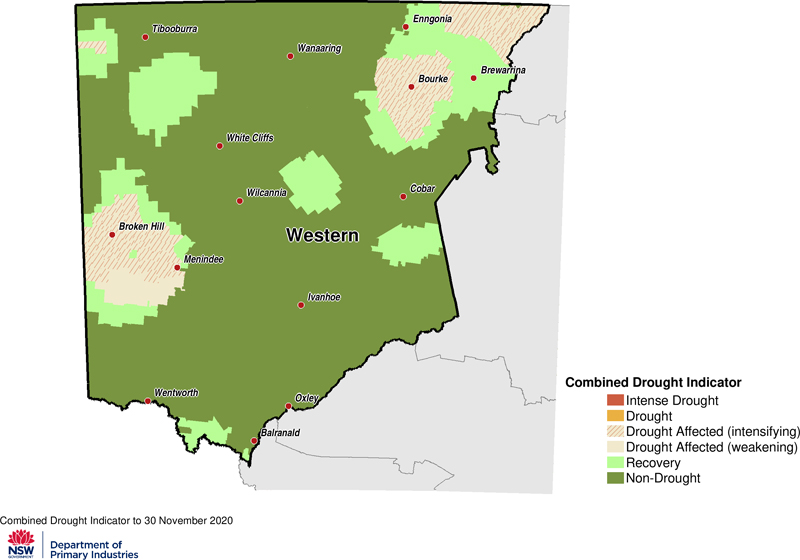
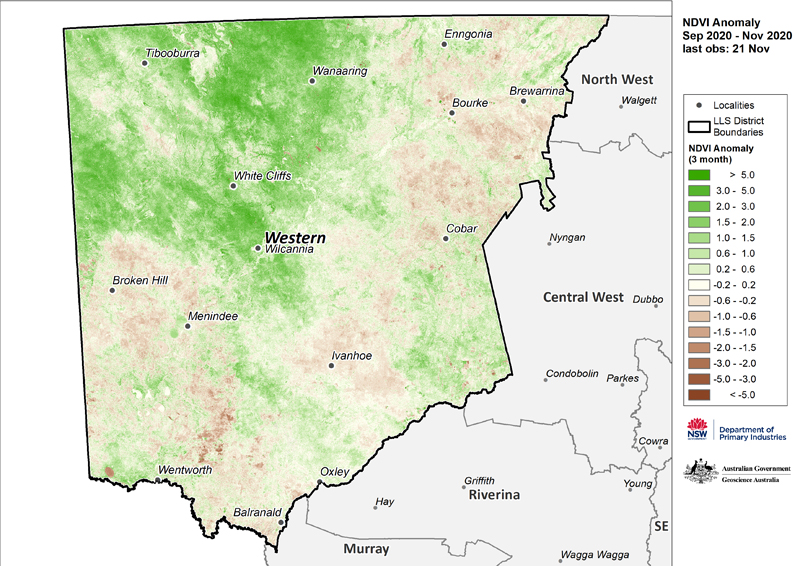
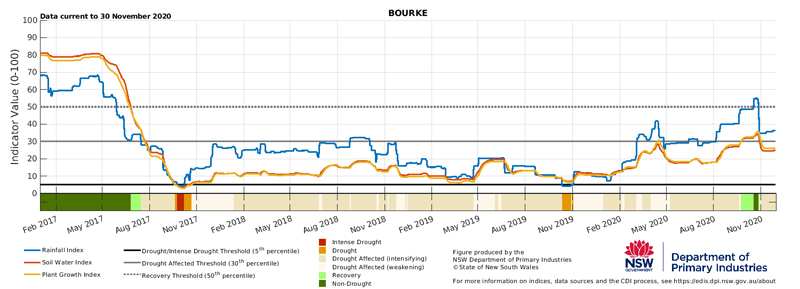
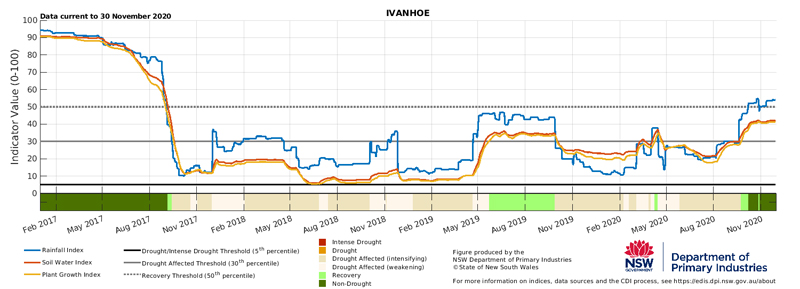
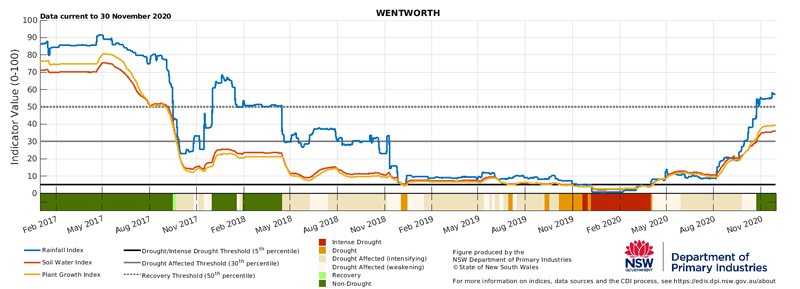
North West, Northern Tablelands and North Coast regions
There has been little change in the Combined Drought Indicator (CDI; Figure 17) across the three northern Local Land Services regions since the October Update. Although October rainfall caused an expansion in the area of the Non-Drought category, November rainfall was below average. The northern areas of the region require additional consistent rainfall to improve soil water storage and pasture conditions for triggering drought recovery.
The time series charts (Figure 19) show the individual response of the drought indices for Moree, Walgett, Tenterfield and Lismore. There have been variable agronomic responses to rainfall in recent months. The drought indices continue to improve at Walgett and Moree where the continuation of rain has maintained the recovery from drought. Lismore highlights the importance of adequate follow-up rain. After a relatively dry eight months, follow-up rainfall remains crucial for sustaining any improvements gained in autumn. Tenterfield has experienced slight improvements to the rainfall index over the last six months and continues to lag in drought recovery. Further rainfall is crucial to maintain any recent improvements. While the rainfall outlook for this region is promising, NSW DPI continues to monitor the area closely.
The time series charts (Figure 19) show the individual response of the drought indices for Moree, Walgett, Tenterfield and Lismore. There have been variable agronomic responses to rainfall in recent months. The drought indices continue to improve at Walgett and Moree where the continuation of rain maintained the recovery from drought. Lismore highlights the importance of adequate follow-up rain. After a relatively dry eight months, follow-up rainfall remains crucial for sustaining any improvements gained in autumn. Tenterfield has experienced slight improvements to the rainfall index over the last six months and continues to lag in drought recovery. Further rainfall is crucial to maintain any recent improvements. While the rainfall outlook for this region is promising, NSW DPI continues to monitor the area closely.
The Combined Drought Indicator (CDI) is a tool that monitors drought conditions across NSW. The drought categories are based on assessing the response of three drought indicators: soil water, plant growth and rainfall. The indicators track the data over the past 12 months and shows how the indices are tracking compared to the long-term averages. The information provided in the map is aggregated to a Parish level and provides a regional assessment of conditions. Variability within and between farms is possible and this may not be reflected in the CDI map.
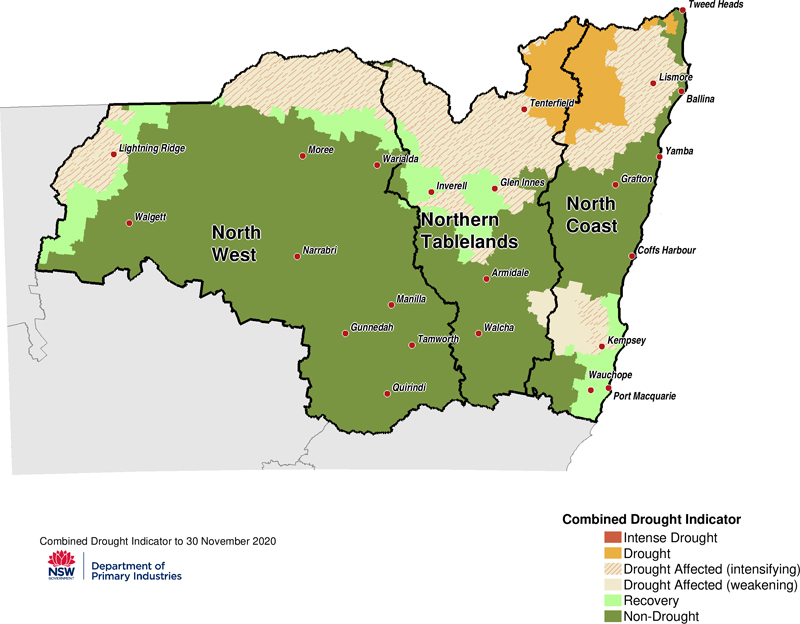
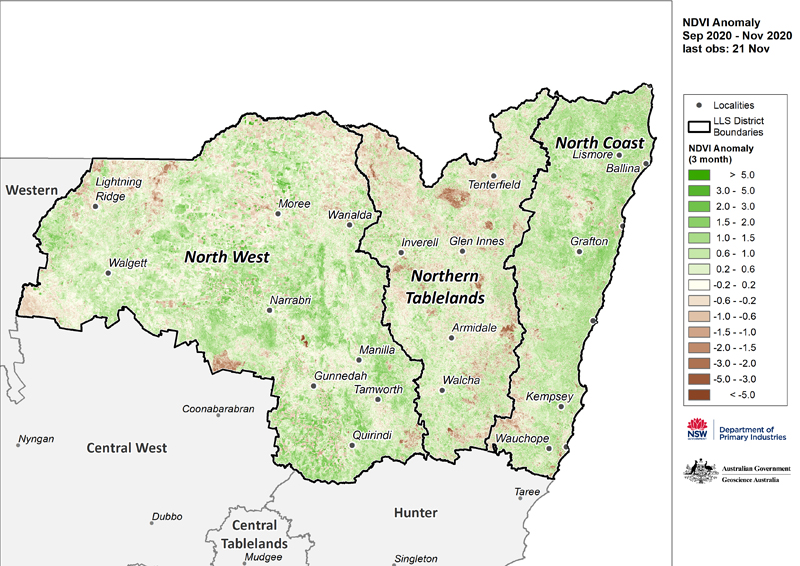
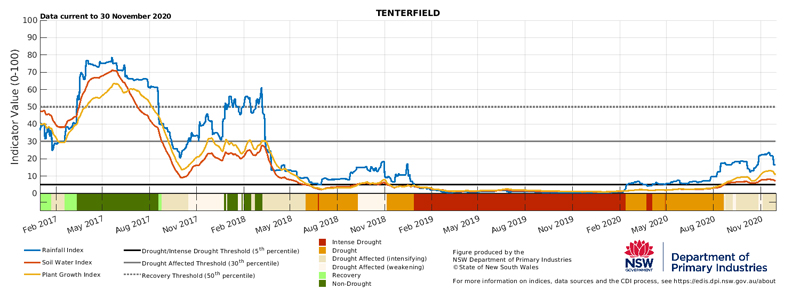
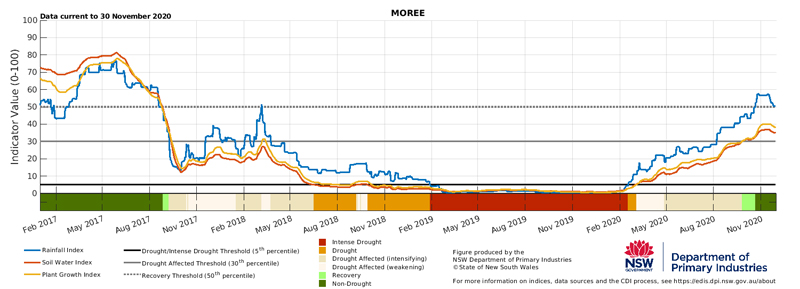
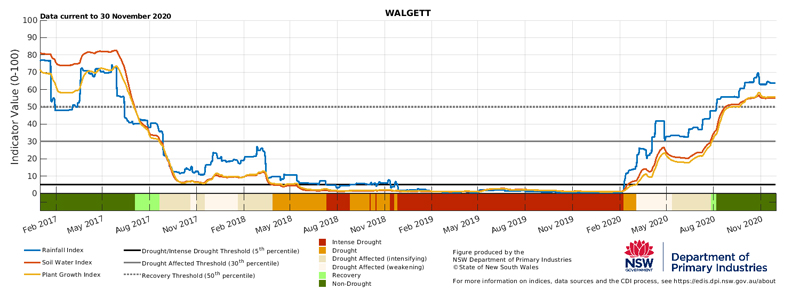
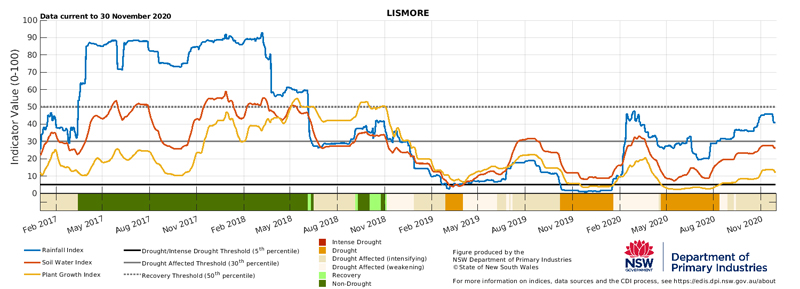
Central Tablelands, Central West, Hunter and Greater Sydney regions
The Central West, Central Tablelands, Hunter and Greater Sydney Local Land Services (LLS) region continued a strong transition through drought recovery during November. Winter and Spring rainfall has aided recovery in all four LLS regions, especially in the Central West and Greater Sydney where recovery has been occurring longer (Figure 20). Rainfall during the month further strengthened recovery in the Central Tablelands and Hunter LLS regions.
The seasonal NDVI anomaly data (Figure 21) continues to show above average levels of plant greenness across large areas of these LLS regions. The data indicates that improvements gained from rainfall received earlier in the year have been maintained in most areas at the end of November. However, there has been a slight reduction in the plant greenness levels in the western parts of the Central West LLS region. The bushfire impact remains evident in parts of the tablelands.
The time series charts (Figure 22) show the individual response of the drought indices for Cowra, Condobolin and Singleton. Rainfall in recent months has improved the indicators at all locations and shows that strong drought recovery has been occurring throughout spring.
The Combined Drought Indicator (CDI) is a tool that monitors drought conditions across NSW. The drought categories are based on assessing the response of three drought indicators: soil water, plant growth and rainfall. The indicators track the data over the past 12 months. and shows how the indices are tracking compared to the long-term averages. The information provided in the map is aggregated to a Parish level and provides a regional assessment of conditions. Variability within and between farms is possible and this may not be reflected in the CDI map.
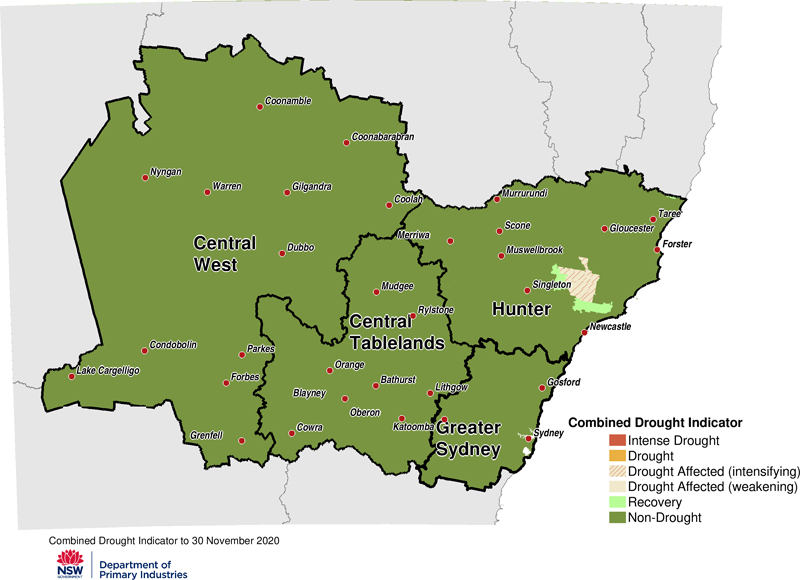
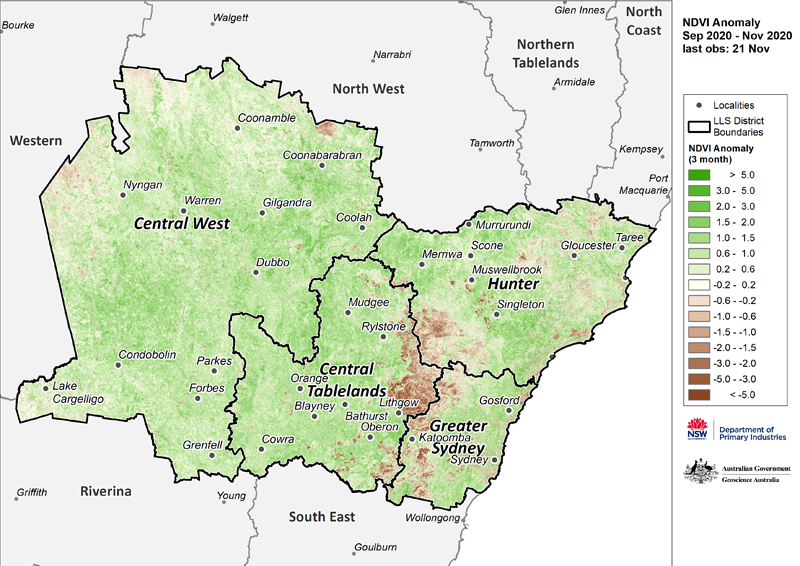
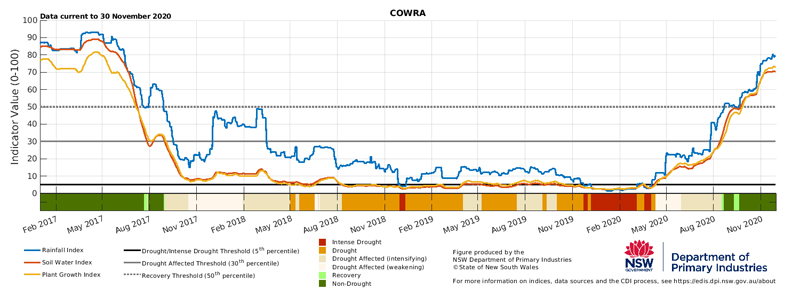
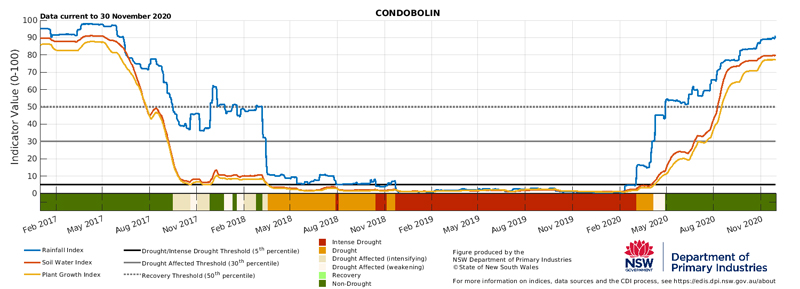
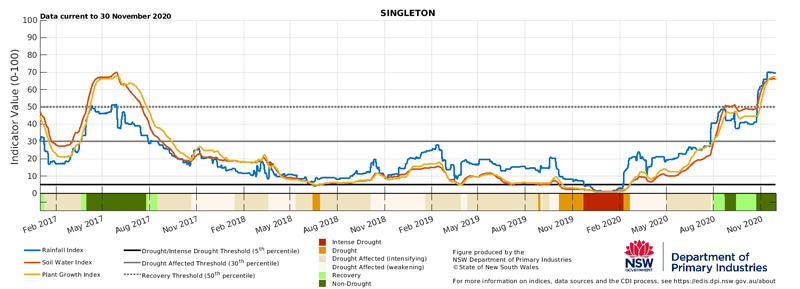
South East region
Conditions continued to improve in the South East Local Land Services region during November. The Combined Drought Indicator (CDI; Figure 23) shows an expansion in the area of the Recovering and Non-Drought categories across southern parts of the region during the month (Figure 25). Rainfall also continued the strong transition towards recovery that has been ongoing since winter in the northern parts of the region.
The seasonal NDVI anomaly data (Figure 24) shows higher than expected levels of plant greenness across much of the region for the September to November period. Some regions in the south are still experiencing below average greenness despite some improvement since the October update. The areas impacted by bushfires continue to have well below average plant greenness.
The time series charts (Figure 25) show the individual response of the drought indices at Bega, Goulburn and Cooma. The plant growth index has begun to respond in all examples now that further rainfall and spring temperatures have increased potential growth rates, however agronomic recovery is still lagging rainfall. Despite improvements, it is likely that areas in the south east will need further follow rainfall due to a longer duration of Intense Drought conditions persisting later throughout 2020. While the rainfall outlook for this region is promising, NSW DPI continues to monitor the area closely.
The Combined Drought Indicator (CDI) is a tool that monitors drought conditions across NSW. The drought categories are based on assessing the response of three drought indicators: soil water, plant growth and rainfall. The indicators track the data over the past 12 months and shows how the indices are tracking compared to the long-term averages. The information provided in the map is aggregated to a Parish level and provides a regional assessment of conditions. Variability within and between farms is possible and this may not be reflected in the CDI map.
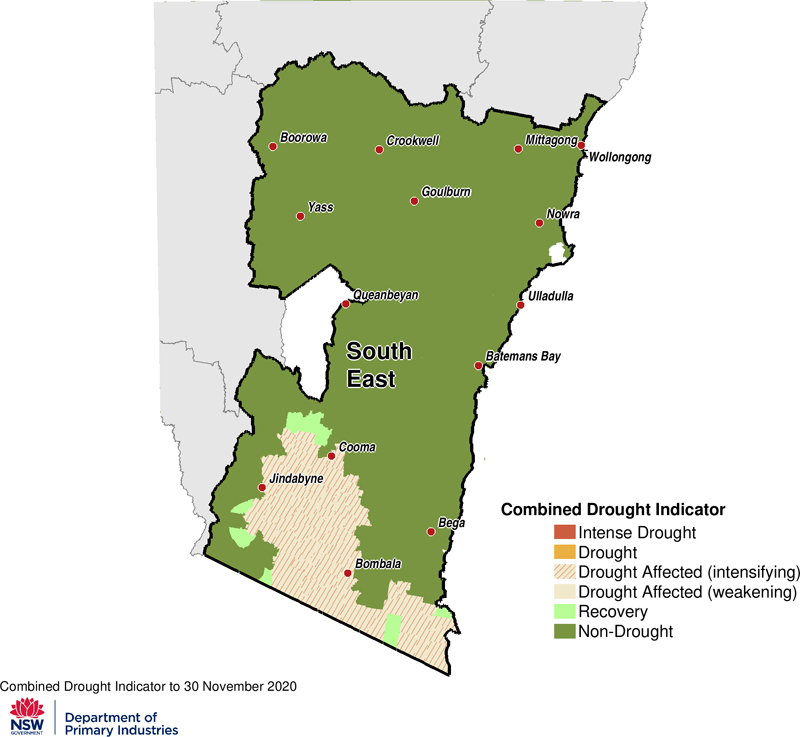
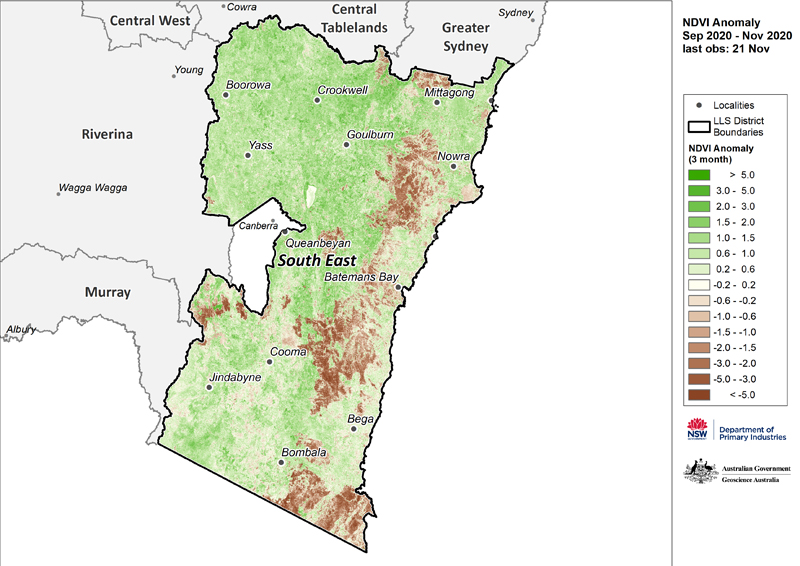
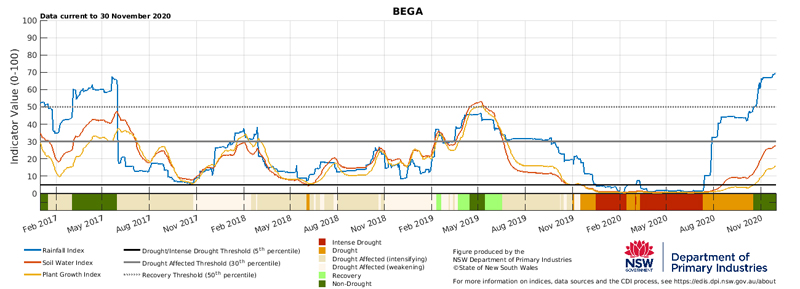
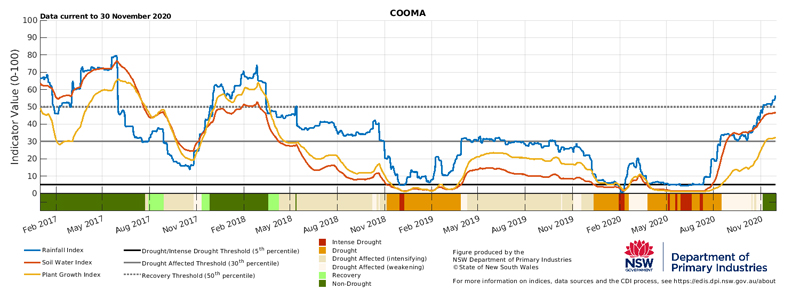
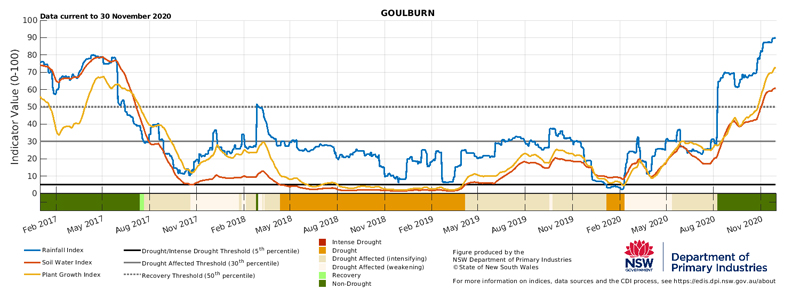
Official national outlook
The latest official national outlook was released by the Bureau of Meteorology (BoM) on 03 December 2020. The outlook indicates that December to February rainfall is likely to be above average for most of Australia. The west coast of Tasmania is near average.
Daytime temperatures for December to February are likely to be warmer than average across parts of south-east, Tasmania and far western Australia, as well as along Australia’s northern coastline. Overnight temperatures very likely to be warmer than average across Australia.
NSW outlook
NSW currently has a moderate to high chance of exceeding median rainfall in the December to February period (Figure 26). Daytime temperatures for December to February are likely to be warmer than average across parts of the south-eastern Australia, Tasmania, far west WA and along the QLD and NT coastlines. Overnight temperatures are very likely to be warmer than average across Australia. There is a high probability of warmer than median overnight temperatures across the state.



Global climate drivers
El Niño–Southern Oscillation (ENSO)
The Bureau of Meteorology’s (BoM) El Niño-Southern Oscillation (ENSO) Outlook was released on 24 November 2020. A La Niña event in the tropical Pacific Ocean continues. The Australian and international climate models indicate that La Niña could persist until at least February 2021. A La Niña event typically increases the likelihood of above average rainfall across much of Australia during spring, and across much of eastern Australia during summer.
Sea surface temperatures in the central and eastern Pacific, as well as most atmospheric indicators including trade winds and equatorial cloudiness remain at La Niña thresholds. The Southern Oscillation Index (SOI) has returned to La Niña levels since the October update. Trade winds continue to remain stronger than average. Generally, a sustained strengthening of these trade winds occurs during the development and throughout a La Niña event.
Southern Oscillation Index
The 30-day Southern Oscillation Index (SOI; Figure 29) for the 30 days ending 22 November was +5.7, which is more consistent with La Niña. The 90-day SOI value was +7.9.
Sustained positive values of the SOI greater than +7 are typical of a La Niña event.
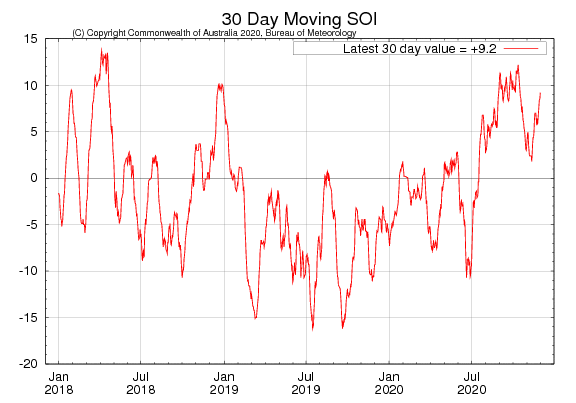
Sea surface temperatures (SST)
Monthly sea surface temperatures (SST) were cooler than average extending across the tropical Pacific Ocean, and south of the equator in the eastern Pacific during November (Figure 30). Warm anomalies were present in the western Pacific, extending into the Maritime Continent and water to the north, east and west of Australia.
The latest values of the three NINO indices in the tropical Pacific for the week ending 22 November were: NINO3 −0.9 °C, NINO3.4 −1.0 °C, NINO4 −0.4 °C.
Persistent NINO3 or NINO3.4 values warmer than +0.8 °C are typical of El Niño, while persistent values cooler than −0.8 °C typically indicate La Niña.
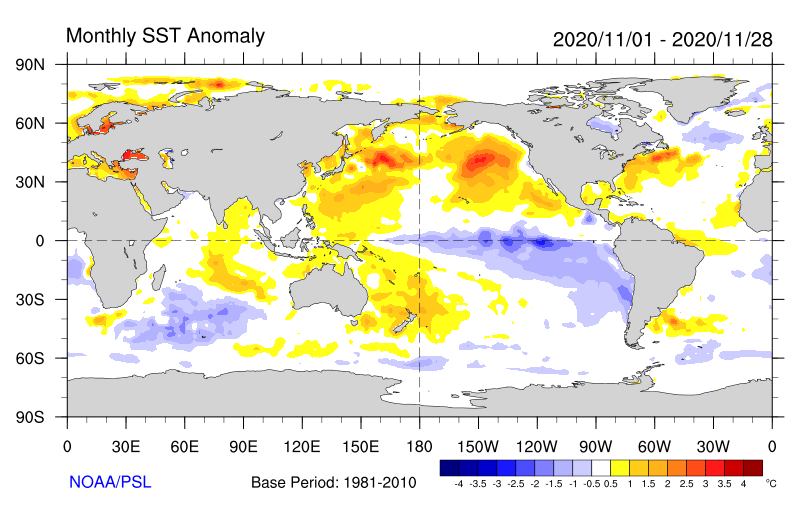
Sea sub-surface temperatures
The four-month sequence of equatorial Pacific sub-surface temperature anomalies (to 19 November) shows the top 200 m of the equatorial Pacific near and to the east of the Date Line is cooler than average (Figure 31). The strength and extent of cooler than average water has increased since July. Weak warm anomalies persist in the far western equatorial Pacific.
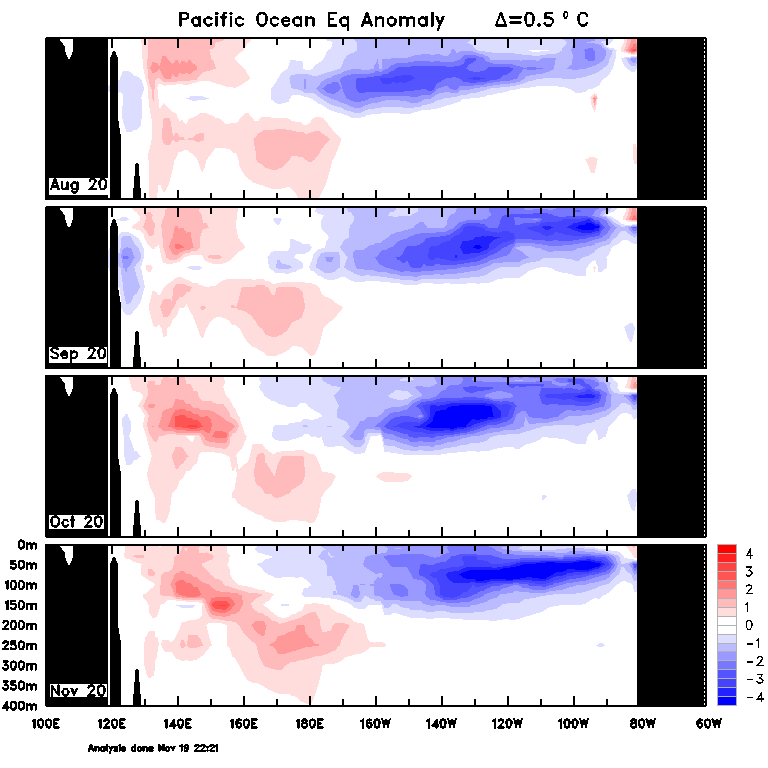
Indian Ocean (IOD)
The Indian Ocean Dipole (IOD) is currently neutral, however parts of the Indian Ocean are generally warmer than average. The latest weekly value of the IOD index to 22 November was +0.2 °C. Most models suggest it will remain neutral for during summer. The IOD index needs to remain at or cooler than −0.4 °C for eight weeks for it to be classed as an official negative IOD event.
The IOD peaks in spring, buts its influence on Australian weather patterns decreases rapidly when the southern hemisphere wet season arrives at the end of spring.
Southern Ocean (Southern Annular Mode – SAM)
The Southern Annual Mode (SAM) is currently neutral but is expected to remain positive into early 2021 (Figure 32). A positive SAM during spring is typically associated with wetter and cooler than average conditions in parts of eastern Australia. La Niña tends to favour positive SAM during spring and summer. This typically enhances the wet signal in eastern Australia.
The Southern Annular Mode (SAM) refers to the north-south shift of rain-bearing westerly winds and weather systems in the Southern Ocean compared to the usual position. This indicator can be quite volatile and generally influences weather conditions on 1-3 week timescales. SAM forecasts are highly uncertain beyond 2-3 weeks.
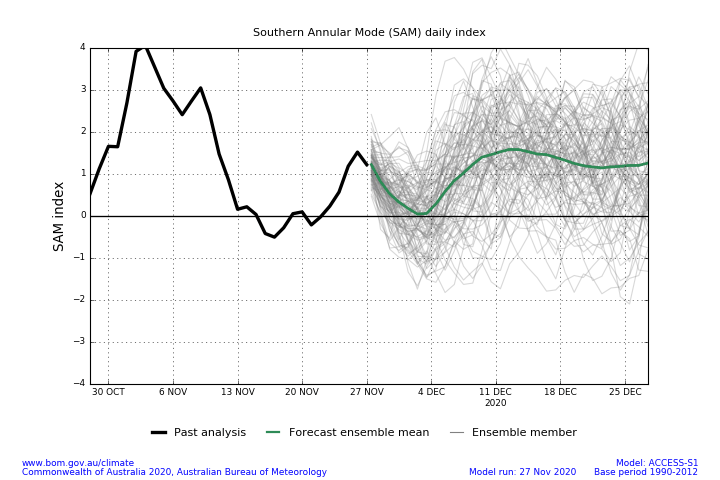
How does it work?

Much of the information in the Seasonal Conditions Report is sourced from the NSW DPI Enhanced Drought Information System (EDIS) ™. The EDIS system is currently available in prototype form and is subject to an intensive ground truthing process. For more information, visit the interactive website via DroughtHub.
EDIS is an ongoing project aimed at improving the quality and timeliness of efforts to monitor conditions across the state. Key features of the system are:
- It tracks drought by using four indicators; rainfall, soil water, plant growth, as well as tracing rainfall trends. Agronomic conditions have equal value to rainfall recorded at meteorological stations.
- The Combined Drought Indicator (CDI) brings this information together and has been designed to characterise developing drought conditions. The key purpose for building the CDI was as a drought early warning system.
- The rainfall, soil moisture and plant growth indicators in EDIS account for conditions over a 12-month window. This provides a compromise between a highly sensitive indicator (e.g. six months) and a less sensitive indicator (e.g. 24 months).
- Climate and remote sensing data drive the information system at a high resolution, but the CDI is reported at a Parish level.
- Because of its configuration and purpose, there will be differences to the indicator used in the National Drought Monitoring Framework (the Australian Rainfall Deficiency Analyser) which relies on rainfall alone.
- The CDI has three drought categories that characterise NSW according to drought intensity as well as the main drivers of a drought event (meteorological, hydrological and agronomic). DPI considers areas Drought Affected to be experiencing a drought event.
- The Drought Affected category encompasses a wide range of conditions from the very early stages of drought entry through to a drought event becoming intense. This enables the drought monitoring system to detect a drought event early. It is also possible to stay in the Drought Affected category for some period of time.
The way in which the indicators are combined to form the CDI is described in Table 1 below.
Table 1: Description of the Combined Drought Indicator framework
CDI Phase | Technical definition | Description - typical field conditions |
|---|---|---|
Intense Drought | All three indicators (rainfall, soil water, plant growth) are below the 5th percentile | Ground cover is very low, soil moisture stores are exhausted and rainfall has been minimal over the past 6-12 months. |
Drought | At least one indicator is below the 5th percentile | Conditions may be very dry, or agronomic production is tight (low soil moisture or plant growth). It is possible to be in Drought when there has been some modest growth, or a few falls of rain. |
Drought Affected (intensifying) | At least one indicator is below the 30th percentile and the rainfall trend is negative over the past 90 days. | Conditions are deteriorating; production is beginning to get tighter. Ground cover may be modest, but growth is moderate to low for the time of year. When indicators are close to the Drought threshold drought conditions are severe. |
Drought Affected (weakening) | At least one indicator is below the 30th percentile and the rainfall trend is positive over the past 90 days. | Production conditions are getting tighter, but there have been some falls of rain over the past month. It is rare to enter the Recovering phase from the Non-Drought category; Usually there is a quick (1-2 week) transition into Drought Affected or Drought. When indicators are close to the Drought threshold drought conditions are severe. |
Recovering | All indicators are below the 50th percentile but above the 30th percentile | Production is occurring but would be considered ‘below average’. Full production recovery may not have occurred if this area has experienced drought conditions over the past six months. |
Non-drought | At least one indicator is above the 50th percentile. | Production is not limited by climatic conditions. |
The NSW State Seasonal Update is provided each month by the NSW DPI Climate Branch.
Information used in this report was primarily sourced from the Australian Bureau of Meteorology, the US National Oceanic and Atmospheric Administration, the International Research Institute for Climate and Society (Columbia University), Geoscience Australia’s Digital Earth Australia Program, and NSW Department of Primary Industries.
Maps in this document contain data which is © Spatial Services – NSW Department of Finance, Services and Innovation (2020), Panorama Avenue, Bathurst 2795 and data which is © Commonwealth of Australia 2020, Australian Bureau of Meteorology, Melbourne. All rights reserved.
The seasonal outlooks presented in this report are obtained from the Australian Bureau of Meteorology and other sources (including World Meteorological Organisation Global Producing Centres). These outlooks are general statements about the likelihood (chance) of (for example) exceeding the median rainfall or minimum or maximum temperatures. Such probability outlooks should not be used as categorical or definitive forecasts, but should be regarded as tools to assist in risk management and decision making. Changes in seasonal outlooks may have occurred since this report was released.
All climate and remote sensing input data is supplied to the Enhanced Drought Information System ™ under the Australian Creative Commons Licence (CCY 4.0) and is made available by the Terrestrial Ecosystem Research Network.
© State of New South Wales through the Department of Regional NSW, 2020. You may copy, distribute and otherwise freely deal with this publication for any purpose, provided that you attribute the NSW Department of Primary Industries as the owner.
Disclaimer: The information contained in this publication is based on knowledge and understanding at the time of writing (December 2020). However, because of advances in knowledge, users are reminded of the need to ensure that information upon which they rely is up to date and to check currency of the information with the appropriate officer of the Department of Primary Industries or the user’s independent adviser.
Published by the NSW Department of Primary Industries. ISSN 2202-1795 (Online). Volume 8 Issue 11.

